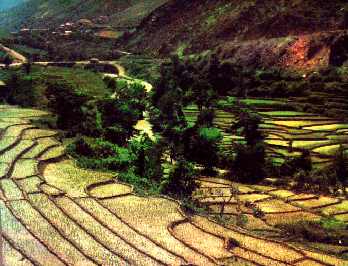


Rice paddies in the Caspian region of Iran
Iran is still very much an agricultural country. During the Pahlavi era, the substantial growth rates of the oil and industrial sectors reduced agriculture's contribution to GNP to about 10 per cent, but 56 per cent of the population still lived in rural areas, and some 40 per cent of the workforce was engaged in agriculture.
The biggest problem facing Iranian agriculture at the time, was that the sector had grown at an average annual rate of only about three per cent during the seventies, while the population had increased at the same pace. Meanwhile the rapid growth in personal incomes had resulted in demand for agricultural products iricreasing by about 10 per cent. The problem was that unless the gap could be be bridged by higher productivity food prices wouldl rise and add to other inflationary trends.
The Government was very much concerned with this problem. During the Fourth Plan (1968-73) public sector investment in agriculture amounted to 65 billion Rials ($942 million), and in the Fifth Plan target it was even higher at 196 billion Rials ($2,850 million) with a further 162 billion Rials ($2,35C million) earmarked for water aid irrigation projects.
The Ministry ol Agriculture and Natural Resources had laid down the following major objectives:
a. Self-sufficiency in strategic agricultural commodities and if possible production of a surplus
b. To raise farmers' incomes to the level enjoyed by other economic groups;
c. To provide more and better food to all Iranians.
The extent of the problem was underlined by the fact that whereas the value of agricultural output in Iran in 1972 was about $3 billion, by 1984 demand for agricultural products was ex pected to reach $10 billion. To meet this demand from domestic sources wiould require an annual rate of growth of about 1 3 per cent, as compared with Third and Fourth Plan actual growtl rates of 2.6 and 4 per cent respectively and a Fifth Plan target of 7 per cent
The Ministry of Agriculture saw the brightest hopes for success in establishing agro-industrial complexes, and concluded agreements fo such complexes with over 550 private sector investors, both Iranian and foreigrn. In order to raise productivity the Ministry was also involved in projects fo greater mechanization, use of chemical fertilizers and high-yield seed, irrigation and ecological acceptable pesticides.
To encourage farmers to mechanize, the import duty on farm machinery and raw materials had been abolished and fertilizers and pesticides were subsidized. One target was to increase the area under irrigation from 3.5 million hectares to 4.2 million hectares by th end of the Fifth Plan.
 To attract private
investment in agriculture, a ten-year tax-holiday was been introduced, and
loans for up to 60 per cent of total investment were available at 6 per cent.
On projects exceeding 25 hectares in size the Government payed up to 100
per cent of the cost of project preparation, 50 per cent of land levelling
costs and 100 cent of the costs of transporting pedigree livestock.
(left, farming in Khusistan)
To attract private
investment in agriculture, a ten-year tax-holiday was been introduced, and
loans for up to 60 per cent of total investment were available at 6 per cent.
On projects exceeding 25 hectares in size the Government payed up to 100
per cent of the cost of project preparation, 50 per cent of land levelling
costs and 100 cent of the costs of transporting pedigree livestock.
(left, farming in Khusistan)
In addition to helping to raise yields by encouraging the use of improved varieties of seed and adopting modern technology, the Government was raising farmers' incomes by its price support policies. The farm-gate price of rice had doubled in four years, the wheat support price had gone from 6,500 Rials to 10,000 Rials per ton and that of sugar beet from 1 ,520 Rials to 2,700 Rials per ton in one year. These were the prices at which the Government guaranteed to buy crops. These prices were set at about 1 5 per cent below international prices, thus giving the Iranian farmer a high return and the incentive to produce efficiently while remaining competitive in terms of world market prices.
Apart from the caviar sector, the Iranian fishing industry was for long inadequately developed. The Caspian Sea had been over-fished and the Persian Gulf under-fished. In the seventies however, stricter control and the introduction of research stations and fish-hatcheries in the north were leading to increased stocks of Caspian white fish, and demand for sturgeon, once virtually a useless by-product of caviar, had picked up. Increased world demand had meanwhile resulted in higher prices for caviar, of which Iran enjoys a virtual monopoly.
Shortages of meat and Caspian fish have encouraged Iranian housewives to turn to Persian Gulf varieties, and the Government-owned Southern Fisheries Company announced that sales had risen from 500 tons to 20,000 tons a year since 1973. Two modern fish-meal plants were also under construction.
Despite this progress, the fisheries potential of the Persian Gulf, which an FAO report had described as one of man's greatest reserves of protein, was still not being fully utilized. There were problems of transportation, nutritional habits and shortages of skilled personnel, but the target was to build up catches from the southern fisheries to perhaps as much as $200 million a year, as one survey had indicated.
The role of agriculture and fishing in the years ahead may probably not be as spectacular as that of the other sectors of the Iranian economy, but with a large and growing population it will continue to be a vital role. A prosperous Iranian farming community could make an enormous contribution, not only in terms of the balance of payments and purchasing power, important though these aspects are, but specially in terms of social justice and continuity of the national heritage.